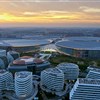Huaxin Town: a logistics and manufacturing powerhouse

Huaxin Town has brought together over 300 express delivery and logistics enterprises over the last decade.
When Zhang Jianfeng, vice president of ZTO Express, first arrived at the Huaxin Industrial Zone in Qingpu more than 10 years ago, he had a visceral sense of the environment — bumpy and dead-end roads and air filled with the smell of soil and fertilizer.
At that time, the headquarters of ZTO Express had just been set up in Huaxin Town and the facilities in the zone were old and worn.
A decade later, the town has taken on a new look. It was the birthplace of the district’s first “100-billion-yuan” (US$14.1 billion) industrial cluster, nurturing the express delivery and logistics industry, as well as the 10-billion-yuan high-end manufacturing industry represented by auto parts and 1-billion-yuan high-tech “new track” industries such as semiconductor chips and biomedicines.
So, what is a “National Logistics Hub?” What is the secret of the town’s mushrooming industrial development?
Over the past decade, Huaxin Town has brought together more than 300 express delivery and logistics companies. Last year, Qingpu’s express delivery and logistics industry reaped in a revenue of 156.8 billion yuan, accounting for 85 percent of the city’s total and 14.8 percent of the nation’s total, with the majority coming from Huaxin.
The disadvantages of Huaxin are obvious. It is far from Shanghai’s downtown area and also far from Qingpu’s center.
The turning point appeared quickly amid rapid development of the e-commerce industry. The town has a traffic network of four expressways and elevated roads, and it takes only 10 minutes from Huaxin to the Hongqiao comprehensive transportation hub, and one hour to reach the core area of the Yangtze River Delta region. It is in the border area of Shanghai, and a center in the region.
In 2017, the National Engineering Laboratory for Logistics Information Technology and Application was unveiled at the headquarters of YTO Express. ZTO, meanwhile, has developed an app supporting the collection and delivery of parcels at its terminal, automated sorting equipment, and digital products such as unmanned aerial vehicles and unmanned vehicles that tackle the woes of “last kilometer” delivery.
Qingpu is also developing the Yangtze River Delta digital line which will string industrial parks and chains along the G50 Shanghai-Chongqing Expressway.
The Hongqiao Digital Logistics Equipment Port in Huaxin, for instance, will lift the digital and intelligent level of the industry centering on the manufacturing of sorting equipment, the research and development of smart robots, UAV technology, application of hydrogen-powered vehicle logistics, and cold-chain transportation technology and equipment.
“We are no longer a ‘sweat industry,’ but an ‘intelligent industry,’” Zhang said.
In Huaxin, the digitalization of logistics industry is empowering other industries such as advanced manufacturing, said Shen Guohui, manager of the industrial zone.
In 2021, ZTO teamed up with Foton Daimler Automotive to provide the supply chain service of auto parts via the combination of express delivery, fast transportation and cloud warehouse resources.
“The change of quality brings quantitative change, as the figures of output value and tax revenue show,” Shen said.
The Hongqiao Digital Logistics Equipment Port boasts an intelligent manufacturing park, a digital valley, a medical innovation city, and an ecological bay. It has recorded year-on-year increases of revenue between 2020 and 2022, hitting 22.1 billion yuan, 28.6 billion yuan, and 31.6 billion yuan, respectively.
















